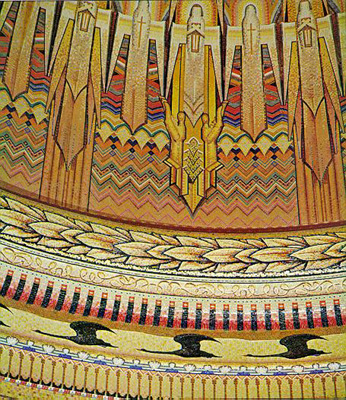The Memorial’s Hall of Memory is decorated with a mosaic designed by Napier Waller. He had fought with the Australian Imperial Force as an artilleryman in the First World War and lost his right arm at the battle of Bullecourt in 1917. He was commissioned to create the mosaic and stained glass windows in 1937. The mosaic is made up of six million glass tiles of 70 different colours, covering more than 1,280 square metres. The tiles were laid in the 1950s by a team of war widows working with an Italian mosaic artist under Waller’s direction. The mosaic commemorates the servicemen and women of the army, navy, air force and auxiliary services in the Second World War
In the 1990s it became apparent that serious cracking in the dome was causing the tiles to fall off. In October 1997 the Memorial initiated a program of restoration, managed by Bligh Voller Nield architects, assisted by International Conservation Services and the English Heritage Authority, which ensured that the work was carried out in accordance with applicable heritage standards. The restoration program involved the removal of about one third of the mosaic, the application of new grout and the painstaking replacement of the tiles.
The work took over two years to complete and cost about $1 million. The restored Hall of Memory was opened by the Queen during her visit to the Memorial on 27 March 2000.


